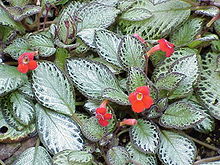Episcia
| Episcia | |
|---|---|

| |
| Episcia reptans | |
| Scientific classification | |
| Kingdom: | Plantae |
| Clade: | Tracheophytes |
| Clade: | Angiosperms |
| Clade: | Eudicots |
| Clade: | Asterids |
| Order: | Lamiales |
| Family: | Gesneriaceae |
| Subfamily: | Gesnerioideae |
| Genus: | Episcia Mart. |
Episcia is a genus of 10 species belonging to the flowering plant family Gesneriaceae. The species are found in the tropical regions of Central America and South America (frequently cultivated elsewhere and sometimes naturalizing in tropical regions). The species are perennial herbaceous plants characterized by a stoloniferous habit, red (rarely orange, pink, blue or yellow) flowers, and frequently have marked or patterned leaves. They are grown in the tropics, and in temperate regions as houseplants, primarily for their attractive foliage. Numerous cultivars have been produced, primarily by selection and hybridization of the species E. cupreata and E. reptans.
For much of the Twentieth century Episcia had a broad circumscription but since 1978 has been restricted to a much narrower one, with the genera Paradrymonia, Chrysothemis, Nautilocalyx, and Alsobia separated from it. The segregation of these genera from Episcia has been supported in recent molecular phylogenies.
Episcias are sometimes called "Flame violets".
Episcia contains the following species:
Section Episcia
- Episcia andina Wiehler
- Episcia cupreata (Hook.) Hanst.
- Episcia duidae Feuillet
- Episcia lilacina Hanst.
- Episcia prancei Wiehler
- Episcia reptans Mart.
- Episcia xantha Leeuwenb.
Section Trematanthera (Leeuwenb.) Feuillet
- Episcia fimbriata Fritsch
- Episcia sphalera Leeuwenb.
- Episcia rubra Feuillet


References
- Feuillet, C. 2008. Folia taxonomica 7. Two new species and a new section in Episcia (Gesneriaceae) from the Venezuelan Guayana. J. Bot. Res. Int. Texas 2(1): 275-280.
- Wiehler, H. 1978. The genera Episcia, Alsobia, Nautilocalyx, and Paradrymonia (Gesneriaceae). Selbyana 5: 11-60.
